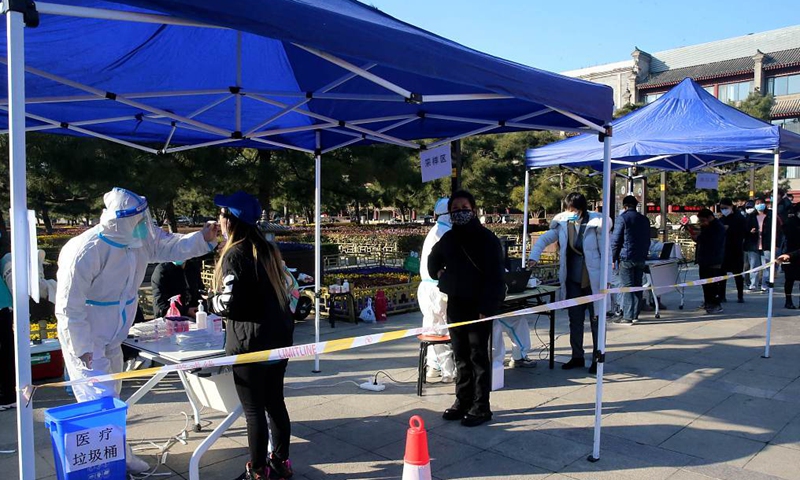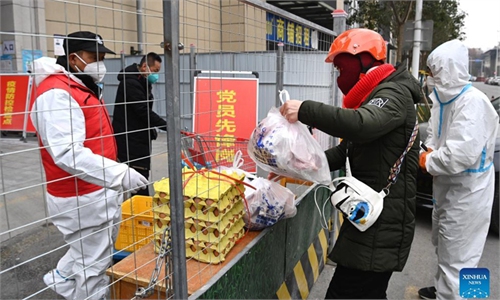Community transmission mostly curbed with strict control in Xi'an: local authority
Residents embrace dynamic zero, urge improvement in local governance

Residents take nucleic acid tests in Xi'an, Shaanxi Province on December 19, 2021. Photo: VCG
Community staff and volunteers in Xi'an, the capital of Northwest China's Shaanxi Province, are working around the clock to meet demands ranging from the delivery of daily necessities and organizing massive nucleic acid testing, to urgent situations like quarantine transportation for its 13 million residents, which entered the 13th day of lockdown on Tuesday.
The city reported 95 COVID-19 cases on Tuesday, 78 found among people under quarantine, while the rest were detected in sealed-off communities.
Local authorities said on Tuesday that community transmission has largely been curbed, and a higher percentage of new cases is found among the quarantined rather than communities.
"Villages in the city," universities and colleges remain the rocky points of epidemic control. Among the more than 1,700 Xi'an cases, 274 were found in 39 "villages in the city" and 195 among university students and teachers.
The severe and complicated epidemic control situation has prompted the city to take the strictest measures since the Wuhan outbreak, leading to livelihood problems among local residents that were hyped by Western media as "dynamic zero failure."
Zeng Guang, a former chief epidemiologist from the Chinese Center for Disease Control and Prevention, said on Tuesday that the latest outbreak in Xi'an is the worst one since the Wuhan lockdown, as it faces the Delta variant, which spreads much faster than the original virus in Wuhan.
Zeng said he hopes that the people of the whole country will give full support to Xi'an, and hopefully the city can discover a new way of handling the outbreak in the short term, if it gets out of control in the early stages.
Having talked to locals including ordinary people, community workers and medics, the Global Times found that despite real difficulties and governance problems that Xi'an authorities have been trying to fix with the assistance of grassroots forces and other provinces and cities, dynamic zero policy continues to be a strategy that locals have highly embraced.
Xi'an has allocated 6.6 million yuan ($951,000) in temporary aid to people in need and set up a contact center for people stranded in Xi'an, the largest city in Northwest China. Some 387 quarantine centers are in operation in the city, according to city authorities.
Besides nucleic acid testing personnel coming to the city's aid from across the nation, supplies are also arriving.
Chinese companies including Alibaba, Tencent, Xiaomi and Geely Auto have sent more than 100 million yuan and supplies including vegetables, meat and masks to Xi'an.
There are online posts where residents with underlying conditions ask for help and complain about poorly organized transportation of high-risk close contacts and conditions of quarantine centers, which reminded people of the early days of the Wuhan outbreak in 2020.
There is chaos as well as complaints, and those voices are easily amplified online, leaving the public outside Xi'an with the impression that the city is in an abyss, when the reality is that the situation is getting back on track, volunteers reached by the Global Times said.
Due to a peak in website visits caused by another round of city-wide testing, the health code system crashed on Tuesday morning. But it resumed within hours, while the last time, it broke down for almost a whole day.
Zhang Li, a 59-year-old community volunteer in Gaoxin district, told the Global Times that "there are some posts criticizing the local governance or complaining of failure in local anti-epidemic work, but I think they can't reflect the whole picture."
As a community volunteer who has frequent contacts with locals, Zhang said most people are calm and understand that it's a difficult time that only solidarity can help them get through.
Another resident of Gaoxin district, one of the hardest-hit areas, told the Global Times that local residents are helping each other. Some managed to contact suppliers to deliver food to the community, and others helped distribute them door-to-door.
The resident complained that government assistance was slow to arrive, and she only received the free vegetable packages on Sunday. "Fortunately the residents helped each other withstand the difficult time," she said.
Yao, a Baqiao district resident, told the Global Times that her community has reduced the testing frequency from daily to every two days as there are no infections nearby, and the testing is now better organized to avoid gatherings and transmission risks.
"We are not advised but allowed to fetch online orders at the community entrance since the community is short of hands to deliver all the packages to residents' doors," Yao said.
Residents also expressed great appreciation for community workers, volunteers and medics, who work around the clock in the fight against the epidemic.
Yang Yang, a social worker in Weiyang district, told the Global Times that he has been on standby since the city's lockdown and barely rested. Their 28 social workers are in charge of serving two communities with about 2,000 households.
A local pediatrician told the Global Times that though some compared Xi'an to the early days of Wuhan, preparedness in terms of medical forces is completely different.
The doctor's hospital has sent teams to Xi'an hospitals designated for COVID-19 patients, and there is no run on resources or understaffing.
"Medical staff like me have full confidence of overcoming this hard time. Most patients have mild symptoms and we have accumulated experience and technologies in treatment," the doctor said, on condition of anonymity.
Two years into COVID-19 epidemic control, Xi'an appeared to present an answer sheet below the standard for a mega-city, and the dismay local people expressed is quite understandable, observers said, but they also pointed out that Xi'an is a city that developed quickly in recent years, while its economic growth and governance haven't caught up with its fast-growing population.
It has more than half as many people as Shanghai, which is widely deemed as a model of precise control, but Xi'an's GDP in 2020 was 25 percent of the latter.
The nucleic acid testing capacities and quarantine sites in Xi'an cannot meet the needs of the current situation, and assistance from across the nation can be seen in the city - from ambulances and testing institutes from other provinces to food and vegetables sent via special channels for free.
Yang Xuedong, a professor of political science at Tsinghua University, told the Global Times that local governance has encountered a major test after the resurgence, and despite successful experience, some places failed to "copy the answer sheet."
But the epidemic is a shared risk and the entire country must tackle it jointly - it's a mechanism that requires government, public, corporate and individual participation and cooperation, to achieve precise control, Yang said, noting that China's system advantage is manifested through support and assistance to areas lacking capacity to deal with a large-scale resurgence and the most vulnerable groups amid an outbreak.

